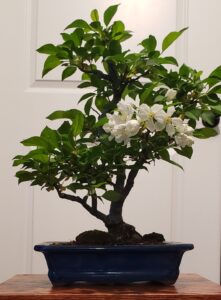Timely Tips
Susan Daufeldt
This is a great time in the bonsai garden. Well, it is and it isn’t. The trees should be really spiffy after all the early summer work. But this is also a time when environmental conditions can create a lot of stress. Watch your trees carefully for the signs. Proper/adequate watering and nutrition will help trees to resist disease. If you see signs of fungal disease and/or pests, address the problem as soon as possible. In my garden, too much sun is an issue and trees showing signs of stress go into more shade immediately. This helps a lot every time. In my first few years in Bonsai, I lost some trees in the course of one afternoon because of too much sun. (While not enough sun is a problem, it generally doesn’t cause immediate death – just large leaves and long, weak internodes.). Too much brutal sun through the day can decrease a tree’s resistance to fungal infections, as well.
Watering in the heat can require some restraint. Be sure the tree actually needs water. Trees’ water uptake may have slowed in the heat and just adding more water to the pot will only reduce oxygen to the roots and create an environment where pathogens thrive (this can result in root-rot). But note: If you go out and the leaves at the end of branches are limp or wilted looking, you need to water immediately and a gentle misting or spray-down will help the tree to recover. (Trees both lose and absorb moisture through their leaves.) There is no watering formula – you have to learn your individual trees and how your environmental conditions affect them. Interestingly, I have a shady area in my bonsai yard where the trees actually require more water than those in the sun. There’s a really good reason for this: That shaded area gets a lot of brutal South, Southwest and West wind. The portion of my bonsai yard that gets the most sun is sheltered from the South, Southwest, West wind. My home sits at the highest point in rural Iowa County. Anyone who’s been here recently could not have failed to notice the giant wind turbines. They are here for a reason and that reason means many of my trees may need water daily or twice a day or three times a day, when my bonsai friends who live in more sheltered locations may not water certain trees for two or three days at a time.
It’s pretty close to time to stop pruning on deciduous trees, if you haven’t already done so. Trees will grow when and where you cut them during the growing season. If you keep on cutting, the tree will be pushing new growth when it should be preparing for a long winter’s nap. This is a month when we need to begin to think about that transition. It seems a long way away, but it’s really just around the corner. And in the middle of show prep and all that jazz, we need to keep the seasonal nature of the art in mind.
If you have pine, early August is the time to start fertilizing them. Recently repotted tropicals should also be ready for fertilization. Remove weak, yellowed, foliage from junipers. Watch your wire -especially on deciduous trees. Wire bite is most likely to occur in the crown of the tree or where branches have been sharply bent, but can show up anywhere. Be sure to rotate trees so that they get sun evenly on all sides. If your trees are against a wall or fence, you can lose half a tree in one season by failing to rotate it.
Have a great month and be sure to contact someone in the club for help if you need it. That’s why we have a club!
Information in this month’s Timley Tips specifically relating to conifers and tropicals was gleaned from prior Timley Tips written by John Denny.
Susan Daufeldt
This article is being reposted with permission from the Iowa Bonsai Association Newsletter, August 2021 Volume 82, Issue 6



